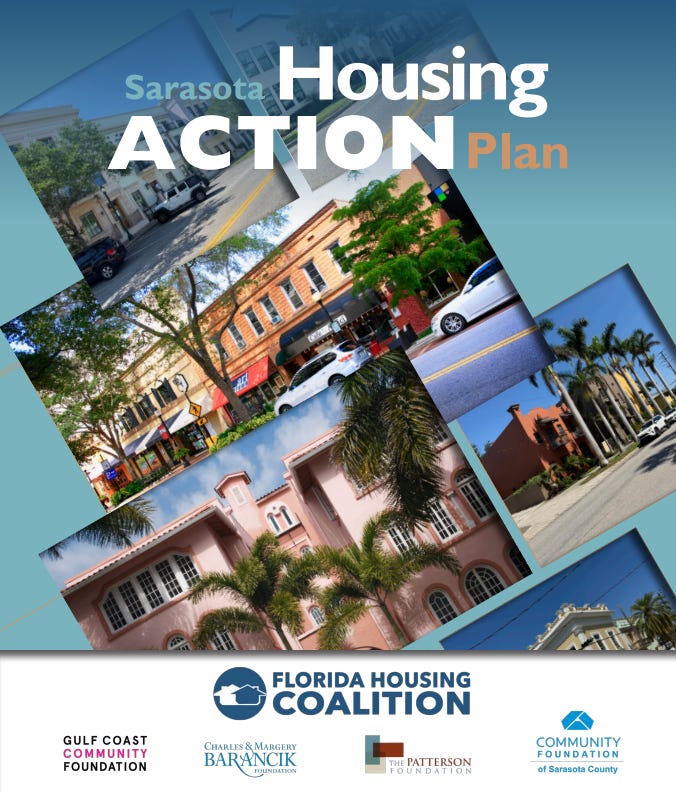Sarasota Housing Action Plan Sparks Community Momentum
Takeaways from my presentation to the Sarasota Chamber of Commerce’s State of the Community Event on Affordable Housing on July 15th
For the past year, the Florida Housing Coalition has worked closely with the Gulf Coast Community Foundation, the Charles & Margery Barancik Foundation, The Patterson Foundation, and the Community Foundation of Sarasota County to develop a blueprint that empowers local housing advocates to advance affordable housing solutions. These four community groups are pillars of the Sarasota community and are leaders in advocating for affordable housing. This effort culminated in the release of a Sarasota Housing Action Plan – a tool we hope can be an organizing force for the community to rally around.
This week, I had the pleasure of speaking at the Sarasota Chamber of Commerce’s State of the Community Series about the state of affordable housing in Sarasota County and share highlights from the new Action Plan. A good news segment about the event was aired on Sarasota’s local ABC affiliate.
In my presentation, I outlined key data on affordability challenges, market trends, and the mismatch between wages and housing prices – particularly for low-wage workers who face the greatest barriers. After examining current shortages and future needs, our team proposed an ambitious but achievable county-wide goal: 15,000 new affordable homes for the low-wage workforce by 2035. With the right policies, partnerships, and investments, this goal is within reach. Who doesn’t love a good numerical goal that could be chantable by the community? (“15,000 homes in ten years! 15,000 homes in ten years! 15,000 homes in ten years!)
After speeding through the housing needs data – which, while sobering, can sometimes feel overwhelming – we shifted focus to solutions. I shared our five-part blueprint designed to guide policymakers, builders, capital partners, and housing advocates in addressing Sarasota County’s affordable housing challenges head-on. The audience posed some great questions on issues such as permitting reform, pre-approved development plans, housing preservation, TIF financing, funding a local affordable housing trust fund, inclusionary zoning, and a whole lot more. It was encouraging to see so much interest and engagement around concrete, actionable steps.
What is the Five-Part Blueprint for Sarasota County?
The Sarasota Housing Action Plan is built around a Five-Part Blueprint that offers local policymakers and community leaders a practical set of public policy and investment strategies to build and preserve more affordable homes. While each part has a unique focus, they all share one essential ingredient: strong collaboration between the public and private sectors. Here’s a closer look at each piece of the Blueprint:
1. Deploy all possible funding for affordable housing.
Public and private capital are both critical in creating homes that the low-wage workforce can afford. This means establishing and creating local affordable housing trust funds, leveraging every available public funding tool, providing fee and property tax relief where feasible, and engaging private capital and community partners to support long-term affordability.
2. Modernize zoning to expand housing opportunities.
Land use policy and regulatory reforms are key to unlocking more housing of all types. The Blueprint outlines strategies to allow more homes – of different types and sizes – efficient, resilient locations. These including permitting more housing types by right, reducing minimum lot size requirements, modestly increasing density where appropriate, and streamlining permitting processes. In some cases, requiring affordable units can also succeed when paired with healthy incentives.
3. Dedicate public and private land to affordable housing.
Many public agencies own land that could be used to build affordable homes — advocates can push for these properties to be prioritized for community benefit. Private entities can also step up by dedicating land or committing resources to secure buildable sites near jobs, services, and amenities.
4. Form and sustain strong partnerships that deliver results.
Collaborations across public, private, and nonprofit sectors are essential to long-term success. These partnerships can pool resources, share expertise, and elevate mission-driven developers. By working together, communities can meet housing needs that no single sector can tackle alone.
5. Put people at the center of housing solutions.
Community engagement is essential to shaping effective, equitable affordable housing solutions. By engaging residents early and meaningfully, communities can build public support, surface new ideas, and ensure housing investments reflect real needs. Broad engagement also helps reduce NIMBY opposition by making sure advocates—not just developers—are leading the conversation.
The Buzz is Alive!
After spending over an hour with this engaged group, it’s clear there is real momentum in Sarasota County to take on housing affordability challenges. I left Tuesday’s sold-out event deeply impressed by the level of interest and the shared commitment to being part of the solution.
Local chambers of commerce, business leaders, philanthropies, financial institutions, real estate professionals, nonprofits, schools and universities, and other key community partners all play a vital role in building coalitions ready for action — and this event brought them all together. The room was packed with elected officials, businesses, advocates, and funders who have the resources, connections, and political will needed to make meaningful progress.
Kudos to the Sarasota Chamber for organizing such a powerful event, and to all the housing champions in Sarasota County working every day to keep the momentum going toward a more affordable, inclusive community.




